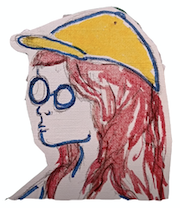An Ode to Op Art
3rd Grade
-
Goal/ Focus
Element of Design- Line, Principles of Design Focus- Movement, Repetition, and Rhythm
This lesson allows students to improve on their understanding of the principles of design, specifically movement, repetition, and rhythm, through analyzing the work of Bridget Riley. After viewing her optical illusions, students will discuss her work while referencing the design principles to identify what they see. Students will also share their opinions on her work before planning their own optically dynamic design using parallel lines, concentric shapes, and high contrast.

-
Materials / Skill/ Technique
Students will use pencil in order to plan their designs on white paper using shape and line repetitively. Then students will use three different tools with black india ink in order to experiment with a variety of line weights. Then students will use india ink to bolden and fill in their designs in order to achieve a visually stimulating high contrasted outcome.

-
Art Historical / Contemporary Context
Bridget Riley was born in 1931 in London, England. As a kid, Riley enjoyed exploring the caves on the coastline of England where she would sit and watch the way the light reflected off the tide pools, creating natural optical illusions.
Students will be able to identify principles of design within the work of Bridget Riley in order to plan and produce their own optically dynamic designs with a focus on line, shape, and contrast.

-
Standards
VA:Cr2.2.3a Demonstrate an understanding of the safe and proficient use of materials, tools, and equipment for a variety of artistic processes.
VA:Cr2.1.3a Create personally satisfying artwork using a variety of artistic processes and materials.
VA:Re.7.1.3a Speculate about processes an artist uses to create a work of art.
VA: Re9.1.3a Evaluate an artwork based on given criteria.
